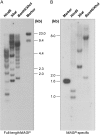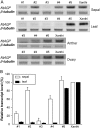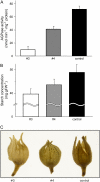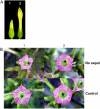A sepal-expressed ADP-glucose pyrophosphorylase gene (NtAGP) is required for petal expansion growth in 'Xanthi' tobacco
- PMID: 17660352
- PMCID: PMC1976561
- DOI: 10.1104/pp.107.102095
A sepal-expressed ADP-glucose pyrophosphorylase gene (NtAGP) is required for petal expansion growth in 'Xanthi' tobacco
Abstract
In this study, a tobacco (Nicotiana tabacum 'Xanthi') ADP-glucose pyrophosphorylase cDNA (NtAGP) was isolated from a flower bud cDNA library and the role of NtAGP in the growth of the floral organ was characterized. The expression of NtAGP was high in the sepal, moderate in the carpel and stamen, and low in the petal tissues. NtAGP-antisense plants produced flowers with abnormal petal limbs due to the early termination of the expansion growth of the petal limbs between the corolla lobes. Microscopic observation of the limb region revealed that cell expansion was limited in NtAGP-antisense plants but that cell numbers remained unchanged. mRNA levels of NtAGP, ADP-glucose pyrophosphorylase activity, and starch content in the sepal tissues of NtAGP-antisense plants were reduced, resulting in significantly lower levels of sugars (sucrose, glucose, and fructose) in the petal limbs. The feeding of these sugars to flower buds of the NtAGP-antisense plants restored the expansion growth in the limb area between the corolla lobes. Expansion growth of the petal limb between the corolla lobes was severely arrested in 'Xanthi' flowers from which sepals were removed, indicating that sepal carbohydrates are essential for petal limb expansion growth. These results demonstrate that NtAGP plays a crucial role in the morphogenesis of petal limbs in 'Xanthi' through the synthesis of starch, which is the main carbohydrate source for expansion growth of petal limbs, in sepal tissues.
Figures









References
-
- Anderson JM, Hnilo J, Larson R, Okita TW, Morell M, Preiss J (1989) The encoded primary sequence of a seed ADP-glucose pyrophosphorylase subunit and its homology to the bacterial enzyme. J Biol Chem 264 12238–12242 - PubMed
-
- Bae JM, Giroux M, Hannah LC (1990) Cloning and characterization of the brittle-2 gene of maize. Maydica 35 317–322
-
- Bae JM, Harn CH, Tae KH, Suh MC, Shin JS, Liu JR (2001) Partial male sterility induced in tobacco by overproduction of mRNA of sweet potato small subunit ADP-glucose pyrophosphorylase. J Plant Physiol 158 1273–1279
-
- Bae JM, Liu JR (1997) Molecular cloning and characterization of two novel isoforms of the small subunit of ADPglucose pyrophosphorylase from sweet potato. Mol Gen Genet 254 179–185 - PubMed
Publication types
MeSH terms
Substances
Associated data
- Actions
LinkOut - more resources
Full Text Sources
Other Literature Sources

